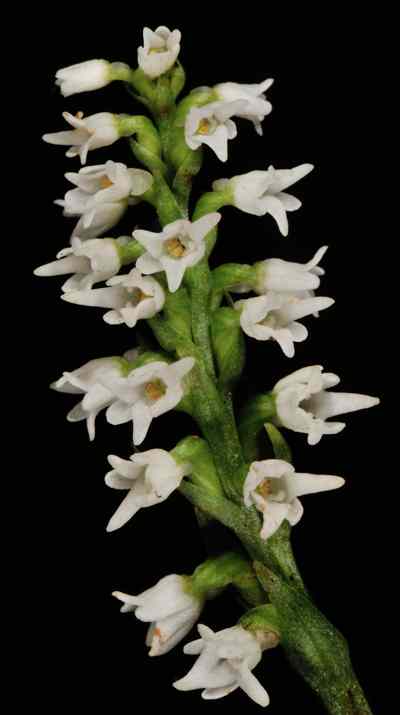The Plant
Terrestrial. Whole plant 12 to 20 cm in height. Tuber small, oblong with few stout short roots arising from the base of the stem (in some cases the bud for the subsequent year arising from the tuber). Stem very slender, long, almost two third of the plant height; with a single tubular, short sheath at its base. Leaf solitary, 2 to 4 cm above the base of the stem, elliptic, and narrowing into a short sheath at its base, 1.5 to 3 cm in length and about 1.5 cm in width. The stem above the leaf is with 3 to 4 lanceolate bracts arranged laxly and diminishing in size to the spike. Flower many in a spike.
The Flower
Flowers small, around 1.2 cm across. Sepals unequal; dorsal ovate, smaller than the lateral, erect; lateral oblong, arranged forward and parallel to the base margins of the lip. Petals lanceolate with broad base and acute apex, longer than the sepals, spreading. Lip lanceolate, longer than the sepals and petals, decurved and with its apex pointing down. Spur very small, compressed. Floral bracts erect, lanceolate, diminishing in length towards the apex of the spike and arising from the lower base of the twisted, beaked and erect ovary.
Sepals, petals and lip are pure white. Spur pale creamy white, translucent. Floral bract green.

The Pursuit
This is one of the rarest of all alpine ground orchids. As it was not studied properly after the monumental publication (King, G. & Pantling, R. 1898), the scientific name of this species was confused. Many “experts” by sitting at their office desks merged this into another species thus making it “extinct” from the scientific world.
As part of my alpine survey I was in the high mountains. The work at those altitudes crosses all extremities. Everyday I was faced a new challenge from power shortage to wildlife. With help and cooperation of the people around and with the blessings of the Almighty, I crossed most of the challenges without much trouble. Moreover, I was regularly guided by a forest official who was very sincere as well as cooperative. With his help I was able to work everyday without much hassle.
On one of such flower hunt days, we decided to cut short our journey due of rains. Normally our practice was to wait for the skies to clear and continue with the work. On that day, my experienced assistant cum weather analyst was of the opinion that there will be heavy rains in the afternoon; hence we were on our way back much earlier than schedule. It was raining quite heavily and visibility was also very poor. The area was home to many bears and it was their breeding season. Hence, we always talk loudly when we pass through that region. The loud talks will always scare those bears and they move inside the forests leaving the trek routes safe for us. As we were descending a small curved path, the forest official lost his grip and slipped down the slope. My other assistant reacted quickly and jumped over him and stopped him from slipping further down. A huge tree trunk blocked their slip further down. By that time I too reacted swiftly by reaching to them and getting hold of one of them. It was more of fun than scary. All of us laughed and made jokes on each other. Usually I loose grip and always tumble even on level trek routes. When I tumble, they joke about it as the disadvantage of people from the plains. On that day the tables turned! As we were about to start our descend the forest officials spotted some unusually small flowers on a few very slender plants. He asked me to have a closer look and to I surprise it was this species – a species never caught on camera. That also seven plants with all of them in bloom. It was such a great moment of my entire orchid hunt, the rediscovery of the species, which will help further detail studies on it. As it was raining heavily we decided to come to the location the very next day for the documentary work. As I had seen wildlife or natural disasters damaging many plants and even their habitats overnight, I was on tenterhooks till the moment we were back to the location the next morning. As the species needed well-detailed documentation and study, we spent the whole day there producing many drawings and photographs. Thank God…it was a very sunny day.
Later on, exactly after 21 days, I spotted a single plant of this species again with flowers. That find was also an accidental one.
Reference:
King, G. &Pantling, R. (1898). The Orchids of the Sikkim-Himalayas.Ann. Roy. Bot. Garden. (Calcutta). Habenaria nematocaulon Hook., Page no 316 – 317.